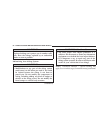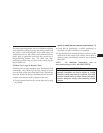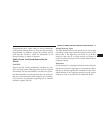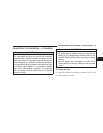
3.
Allow some of the webbing to retract back into the
retractor. As the belt retracts, you will hear a clicking sound
indicating that the belt is now in automatic locking mode.
4. Tighten the lap portion of the belt and allow the excess
webbing to retract back to the retractor. If it still does not
make the child restraint secure, then secure the child
restraint with the Child Restraint Tether Anchor.
NOTE:
Once the belt is in automatic locking mode, you
will not be able to pull any more of the webbing out of the
retractor. In this mode, you will only be able to retract excess
webbing into the retractor to secure the child restraint.
Transporting Pets
Deploying airbags could harm your pet. An unrestrained
pet will be thrown about and possibly injured, or injure a
passenger during panic braking or in a collision.
Pets should be restrained in pet harnesses or pet carriers
that are secured by seat belts.
BREAK-IN RECOMMENDATIONS
A long break-in period is not required for the drivetrain
(engine, transmission, and rear axle) in your new vehicle.
Following these few simple guidelines is all that is
necessary for a good break-in.
For the first 500 miles (800 km):
•
Keep your vehicle speed below the legal, posted speed
limit and your engine speed below 4,000 RPM.
•
Avoid driving at a constant speed, either fast or slow,
for long periods.
•
Do not make any full throttle starts and avoid full
throttle acceleration.
•
Use the proper gear for your speed range.
•
Wait until the engine has reached normal operating
temperature before driving at the recommended maxi-
mum break-in speed.
THINGS TO KNOW BEFORE STARTING YOUR VEHICLE 59
2


















